![]()
Medium format cameras have long been cherished by photographers for their ability to produce images with exceptional detail, rich tones, and a unique aesthetic that’s difficult to replicate in smaller formats. While these cameras were historically the tools of professional studios and well-funded enthusiasts, the growing interest in film photography has created a vibrant market for medium format options that cater to a range of budgets. This guide is here to help you navigate the world of budget-friendly medium-format film cameras and find the perfect model to match your creative ambitions without breaking the bank.
Medium format cameras are distinct from 35mm cameras due to their larger film size, which results in higher resolution and a shallower depth of field. These characteristics make them a favorite for portraits, landscapes, and fine art photography. However, many assume that the medium format realm is prohibitively expensive and reserved for premium brands and niche collectors. The good news? There are plenty of options that deliver stunning image quality and versatility at surprisingly affordable prices. Sure, you’ll pay more than you would for a 35mm camera — no different than the digital world — but you’ll be rewarded with stunningly large negatives and beautiful photographs.
And so, we wanted to highlight a selection of medium-format film cameras that balance quality, usability, and cost. Whether you’re a beginner exploring film for the first time or an experienced photographer looking to expand your toolkit, this list covers cameras that offer excellent value for money. From robust SLR systems to rangefinders to TLRs (twin lens reflex), there’s something here for every budget-conscious film enthusiast.
We’ve even thrown in a few digital options at the end, though be aware even the cheapest digital medium format cameras are not cheap. But many of them have a stunning quality-to-cost ratio.
At a Glance
Medium Format SLRs
Bronica ETR / ETRS / ETRSi
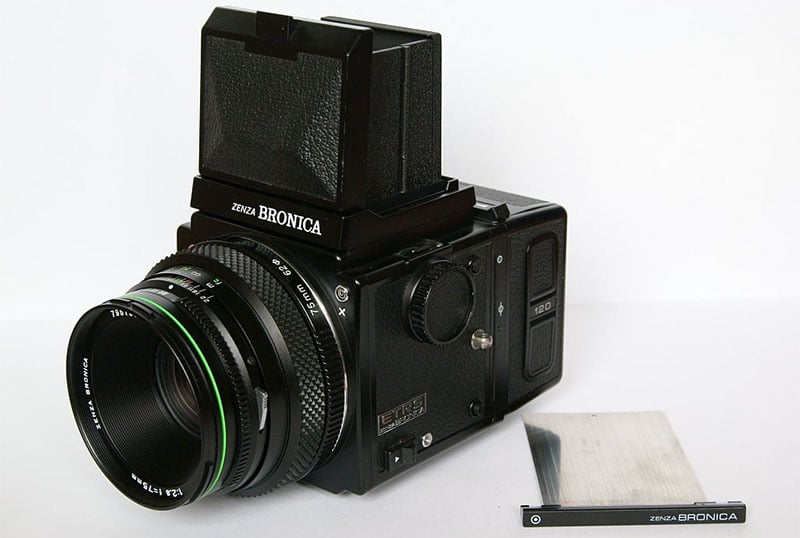
When people think of medium-format cameras, they often imagine big, clunky boxes. But the Bronica ETR and ETRSi break that mold. These 6×4.5 format SLRs are sleek, modular, and surprisingly user-friendly. The ETR is the solid workhorse, while the ETRS steps things up with compatibility for the newer AE II and AE III interchangeable viewfinders. The ETRSi goes a few steps further with TTL flash metering, a traditional bulb mode shutter setting, a locking dark slide, and a mirror lock-up for sharper shots. If you love modular systems, you’ll adore these cameras. Everything swaps out: film backs, viewfinders, and even focusing screens. The Zenzanon lenses they use are no joke, either: sharp, contrasty, and perhaps best of all, affordable.
Both models offer flash sync up to 1/500s via the lenses’ Seiko leaf shutters — a first for Bronica — though they also retain a mechanical shutter speed of 1/500s. It’s perfect for shooting just about anything — portraits, street, landscape, studio, still life… the list goes on. With its lightweight build and affordability, it’s a killer choice for anyone dipping their toes into medium format or looking for an alternative to pricier brands like Hasselblad.
Mamiya M645 / M645 1000S
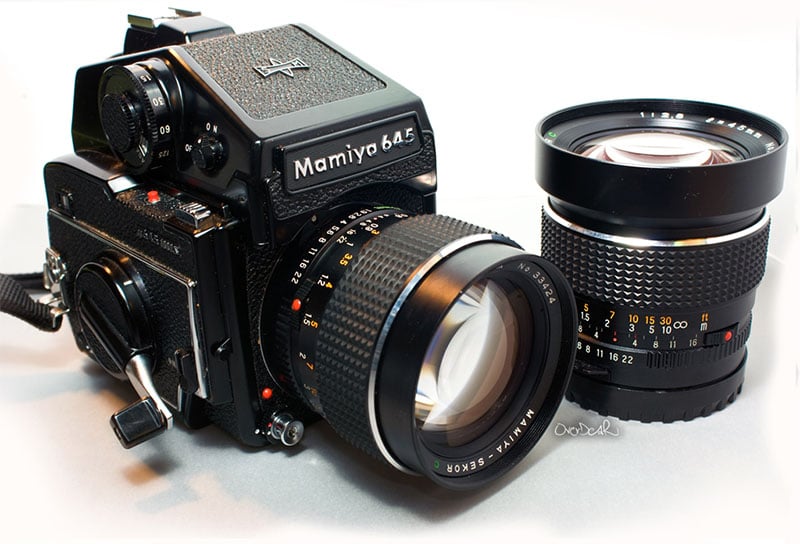
If the Bronica ETR is the minimalist’s dream, the Mamiya M645 is for those who crave simplicity without sacrificing results. The M645 doesn’t try to wow you with modular tricks; it’s just a solid, straightforward camera that gets the job done. The M645 1000S takes everything good about the base model and gives it a little more flair — like a 1/1000s shutter speed (up one stop from 1/500s) for shooting in bright light or with fast film, and a self-timer.
Both cameras use Mamiya Sekor lenses, which are known for their reliability and excellent image quality. The system is aimed squarely at photographers who want 6×4.5 negatives without the bulk of a full 6×7 system. The biggest downside? No interchangeable backs. You’re stuck with your roll until it’s finished. But that’s a small trade-off for the bright viewfinder, buttery-smooth controls, and rugged build quality. Whether you’re shooting weddings, landscapes, or anything in between, the M645 won’t let you down.
Pentax 645

The Pentax 645 is like the golden retriever of medium format cameras: dependable, friendly, and eager to please. With its built-in meter and motorized film advance, it bridges the gap between 35mm ease and medium format quality. Ergonomically, it’s one of the best in its class. The grip feels great in your hands, and everything’s intuitive, even for first-time medium-format shooters.
But don’t let its user-friendliness fool you. This camera means business, especially when paired with the legendary Pentax 645 lens lineup. The results? Crisp, detailed negatives with beautiful tonality. It’s weather-resistant, so you can take it out in less-than-ideal conditions without worry. The main downside? You can’t swap film backs mid-roll, which is a dealbreaker for some. But if that’s not a priority, the Pentax 645 is a fantastic tool for anyone serious about their craft.
Bronica S / S2 and Bronica C
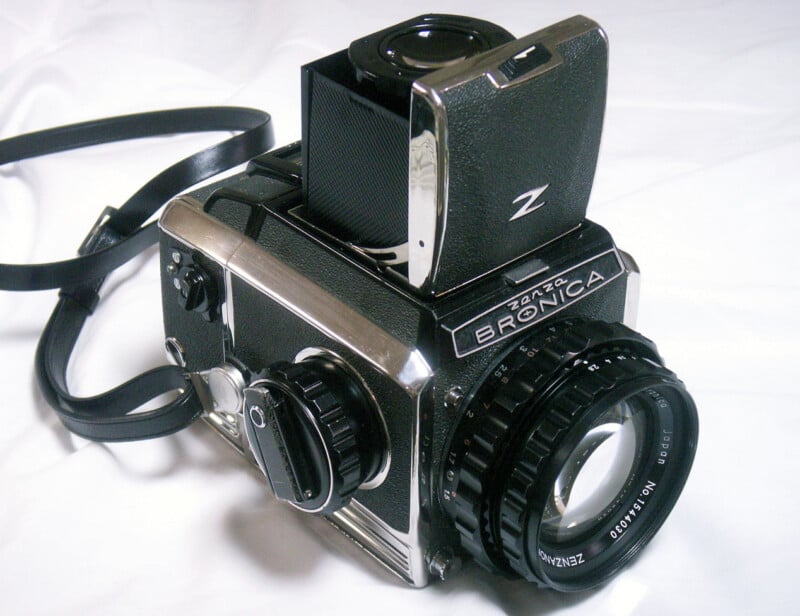
The Bronica S and its S2 sibling have an old-school charm that’s hard to resist. These modular 6×6 cameras are like the vintage sports cars of the medium format world –mechanical, solid, and full of character. They’re hefty, sure, but that weight translates to stability when you’re out shooting. The S2 improves on the original with a faster mirror return and a smoother film advance, making it feel just a little more refined.
The Bronica C strips things down to the essentials — no interchangeable backs, but you still get that classic Bronica quality at a more budget-friendly price. All models use stunning Nikkor lenses, which are some of the sharpest you’ll find in the medium format realm. The downside? They’re not exactly nimble. These cameras demand a slower, more deliberate shooting style. But for portraits, studio work, or landscapes, they’re an absolute joy to use.
Bronica SQ / SQA
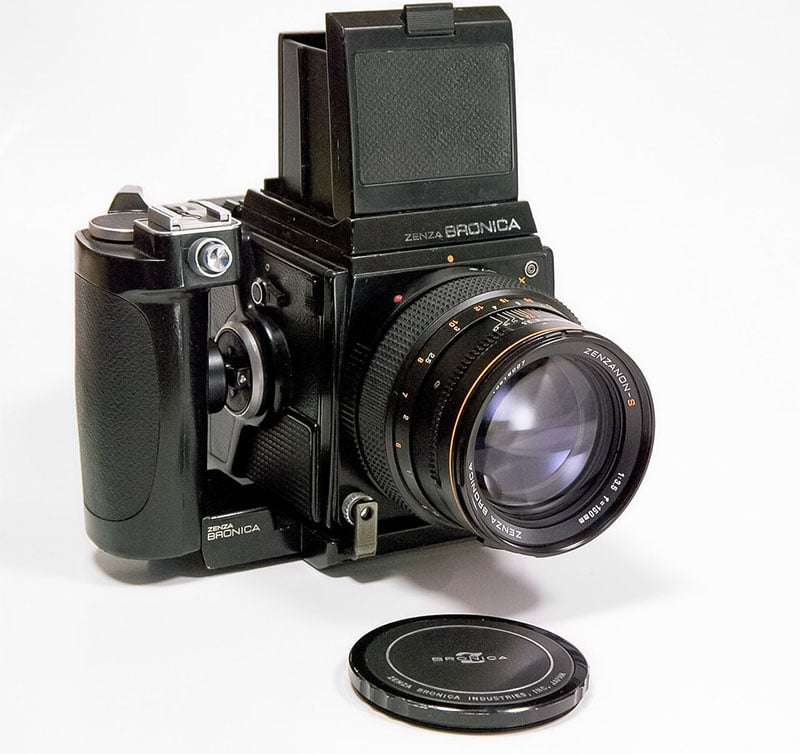
The Bronica SQ series is like the hip younger sibling of the Bronica S. It brings the modularity you’d expect but with a 6×6 square format that makes every frame feel like a work of art. The SQ-A is the standout, with improvements like motorized accessories and better ergonomics. And the Zenzanon lenses? Absolute gems, capable of rendering colors and details beautifully.
One of the joys of the SQ series is its balance — lighter than some of its other modular counterparts but still substantial enough to feel professional. Whether you’re shooting weddings, landscapes, or even street photography, the SQ adapts to your needs. The only catch is that, like any modular system, it requires upkeep. Treat it well, and it’ll give you years of stunning results.
Pentax 6×7 / 6×7 MLU
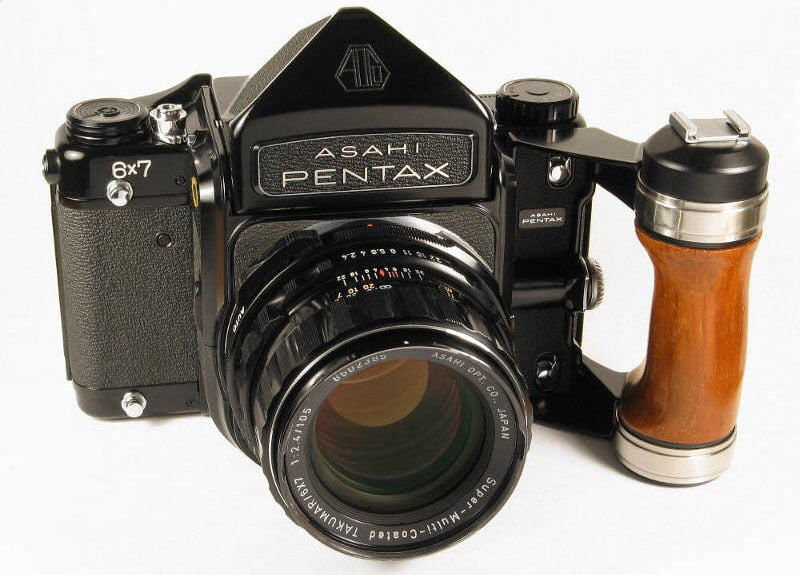
The Pentax 6×7 is affectionately nicknamed the “beast” of medium format cameras — and for good reason. This legendary SLR produces massive 6×7 negatives that deliver incredible detail, tonal range, and depth of field. Designed like an oversized 35mm SLR, it’s surprisingly intuitive to use despite its size, with familiar controls that make the transition to medium format feel seamless.
One standout feature is its compatibility with Pentax’s incredible lineup of Takumar lenses, including the famous 105mm f/2.4 (approximately a 50mm f/1.2 35mm equivalent), known for its dreamy bokeh and sharpness. The Pentax 6×7 MLU (Mirror Lock-Up) model builds on the original with an essential improvement for reducing vibration during long exposures, macro, or landscape work — crucial when shooting at slower shutter speeds with such a large mirror.
However, the Pentax 6×7 isn’t for the faint of heart. It’s big, heavy, and can get tiring to carry during extended shoots. Its focal plane shutter means flash sync tops out at 1/30s, which isn’t ideal for studio flash work. That said, the sheer quality of the images it produces more than makes up for its quirks. Whether you’re shooting landscapes, portraits, or fine art, the Pentax 6×7 is a powerhouse that rewards careful, deliberate shooting with breathtaking results.
Mamiya RB67
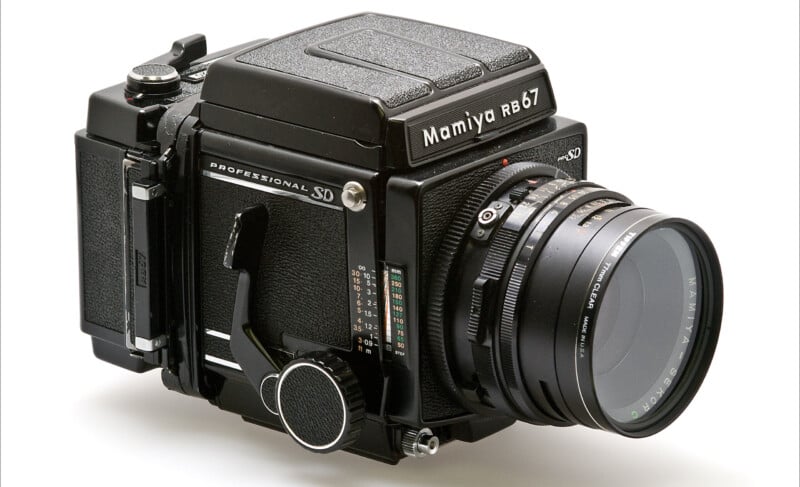
If cameras were tanks, the Mamiya RB67 would be leading the charge alongside the Pentax 6×7. This beast shoots glorious 6×7 negatives and is built like it could survive a fall off a cliff (though I wouldn’t recommend testing that theory). The “RB” stands for “rotating back,” which means you can switch between portrait and landscape orientation without moving the camera — a lifesaver in the studio and the field.
Its bellows focusing system lets you get insanely close to your subject, making it a favorite for macro photographers. And because it’s fully mechanical, no batteries are needed. That’s right — this camera will outlast you in a power outage. Sure, it’s heavy and not exactly the most portable option, but that’s not what the RB67 is about. It’s about control, precision, and creating images so detailed they almost pop off the paper.
I personally own the successor model — the RZ67 — because I prefer its lighter weight, but it’s also considerably more expensive.
Medium Format TLRs
For those who don’t know, a TLR (twin-lens reflex) camera is a classic type of film camera that uses two lenses stacked vertically: one for composing and focusing (the “viewing lens”) and the other for capturing the image on film (the “taking lens”). These cameras are known for their unique waist-level viewfinders (though many have optional eye-level finders available), which display a bright, reversed image on a ground glass screen. This design, along with their in-lens leaf shutters, allows for quiet operation, as there’s no mirror slap or focal plane shutter, and makes them ideal for candid portraits or street photography.
When it comes to medium format TLRs (which is what the majority of TLRs are, though some 35mm TLRs were made), these cameras produce negatives typically in the 6×6 square format. Medium format TLRs often feature fixed lenses (though some, like the Mamiya C series or Koni-Omegaflex M, have interchangeable lenses), and they strike a balance between the portability of smaller cameras and the resolution of larger medium format SLRs.
Minolta Autocord
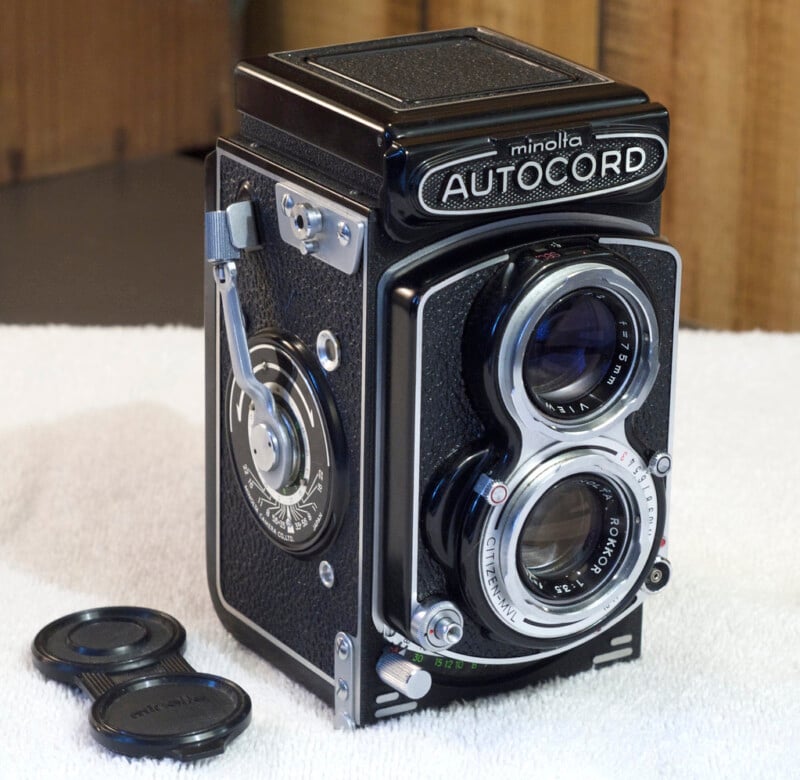
The Minolta Autocord isn’t just a camera; it’s an experience. TLR fans know that finding the right one is like finding the perfect pair of boots — practical, durable, and with just the right fit. The Autocord delivers all that with its ingenious focusing lever, which glides like silk and makes focusing a joy. Then there’s the 75mm f/3.5 Rokkor lens. If you’re after sharpness, contrast, and creamy bokeh, this lens delivers every single time.
The camera is solidly built but not heavy, making it an excellent option for long walks or street photography. It’s also incredibly intuitive — perfect for those who want to dive into medium format without wading through endless manuals. While it doesn’t offer interchangeable lenses or fancy bells and whistles, it doesn’t need them. The Autocord is all about stripping photography down to its essence: composition, light, and that beautifully sharp image on the ground glass.
Mamiya C22 / C33 / C220 / C330
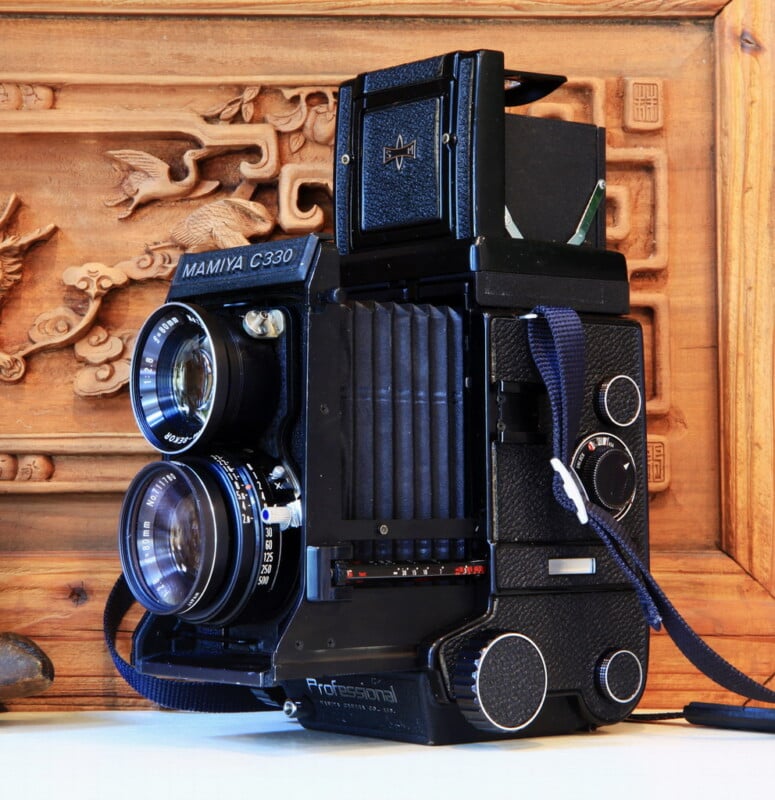
These Mamiya TLRs are like a Swiss Army knife for medium-format photographers. Need a telephoto shot? Swap out the lens. Want to get in close? The bellows focusing will take you there. The C22 and C33 are the older, bulkier models, while the C220 and C330 are lighter and more refined. The C330, in particular, is a standout with its automatic parallax correction, saving you the headache of guessing your framing.
What really sets these apart from other TLRs is the interchangeable lenses. Whether you’re shooting portraits, landscapes, or even macro work, these cameras adapt beautifully. Sure, they’re a bit on the heavy side for TLRs, but the creative freedom they offer is worth the extra weight. Pair one of these with a Mamiya Sekor lens, and you’ve got a combo that can tackle just about anything.
Various Rolleicord Models
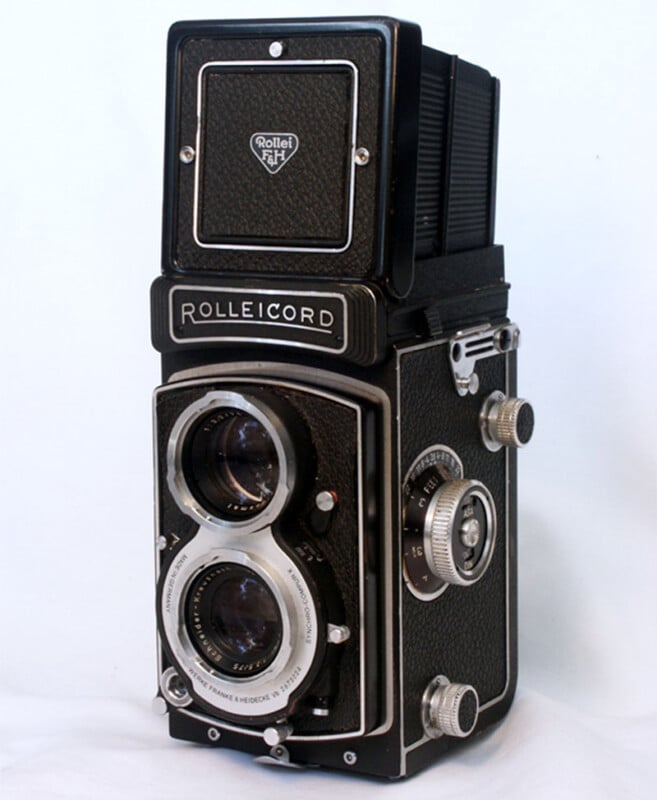
The Rolleicord might be the baby brother of the Rolleiflex, but don’t underestimate it. These cameras are lighter, simpler, and sometimes easier to handle while still delivering those impeccable medium format images Rolleis are famous for. The Schneider-Kreuznach or Zeiss lenses are sharp and produce gorgeous, tack sharp photos. Perfect for travel or casual shooting, the Rolleicord proves you don’t need all the bells and whistles to create magic.
What’s the trade-off compared to the Rolleiflex series? Fewer conveniences — crank film advance and a self-timer are luxuries you might not find on some models. But for photographers who want a dependable TLR without breaking the bank, the Rolleicord is an obvious choice. Its charm lies in its simplicity and portability. Throw one in your bag, and you’ll forget it’s there until it’s time to shoot.
Yashica D
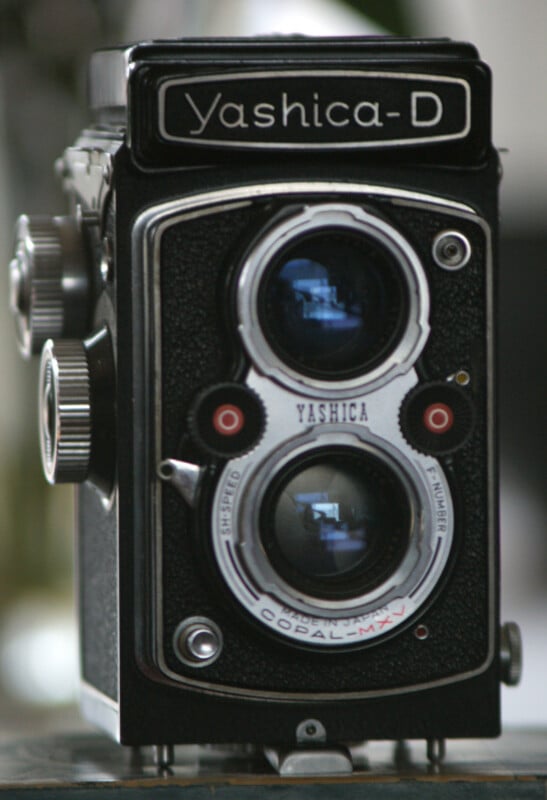
Yashica TLRs are the unsung heroes of medium format photography and the Yashica D is a true gem in the world of TLRs, offering a delightful mix of simplicity, affordability, and solid performance. Designed for photographers who want to explore medium format without breaking the bank, it produces 6×6 negatives that pack impressive detail and tonality, thanks to its Yashikor or Yashinon taking lens (the later and higher-quality four-element Yashinon lens is generally preferred by users).
What sets the Yashica D apart is its build quality—while not as luxurious as a Rolleiflex, it’s sturdy and reliable, with a smooth film advance and a satisfying mechanical feel. It lacks extras like a self-timer or crank film advance, but for many, the stripped-down design is all they need. The Yashica D shines in portraiture, landscapes, and street photography, offering a timeless shooting experience with that unmistakable medium format quality. It’s an excellent choice for both beginners and enthusiasts looking for a dependable TLR with character.
Zeiss Ikon Ikoflex
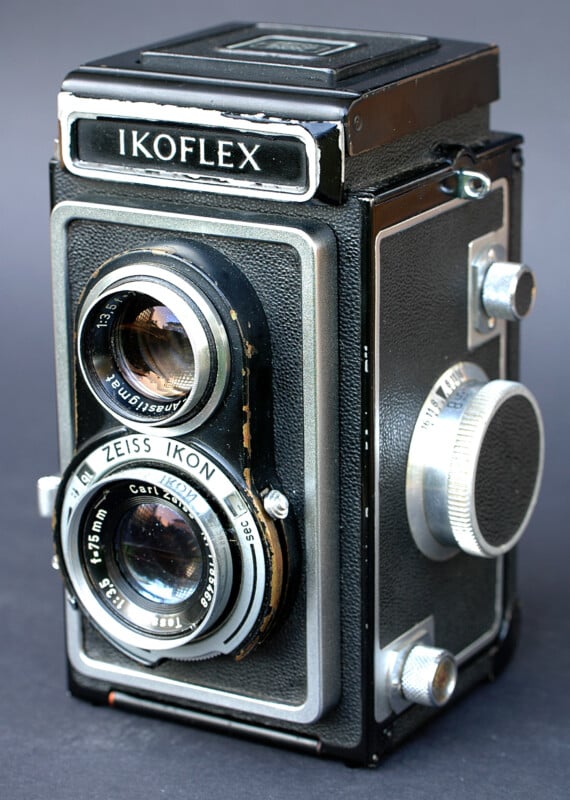
The Zeiss Ikon Ikoflex is pure class. Everything about it feels premium, from its buttery-smooth focusing to its four-element Tessar lens. If you’re after medium format images with that classic Zeiss pop, this TLR will blow you away. It’s a joy to hold, and its compact design makes it perfect for photographers who want high-quality results without lugging around a tank — or depleting their wallet.
The Ikoflex does have its quirks — no interchangeable lenses or backs, and focusing requires a little patience — but it rewards careful shooting with negatives that are packed with detail and contrast. For portraits, landscapes, or vintage-style street photography, it’s hard to beat this combination of craftsmanship, optical quality, and price.
Lomo Lubitel 166
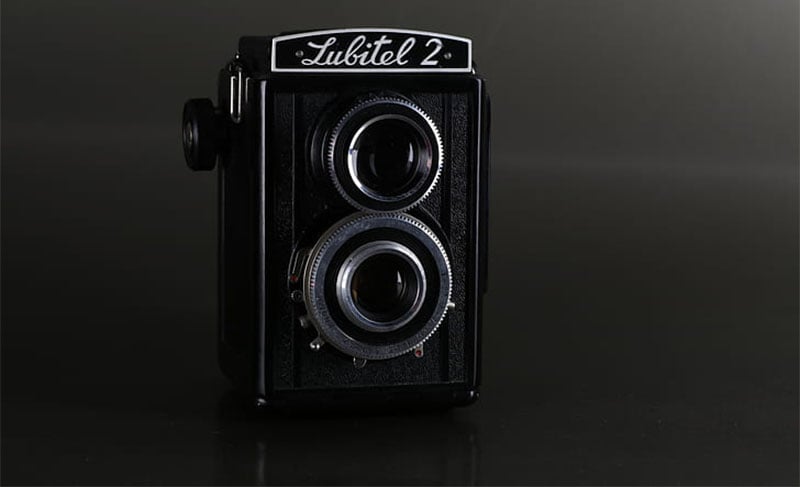
The Lomo Lubitel 166 is quirky, fun, and charming. It’s not here to compete with the big boys like Minolta or Mamiya; it’s here to offer you a different kind of shooting experience. This lightweight TLR gives you 6×6 negatives with a dose of unpredictability that Lomography fans adore. The plastic build and simple optics mean it’s not going to deliver razor-sharp images, but that’s part of the appeal.
The Lubitel shines when you embrace its imperfections. Light leaks? Character. Soft edges? Artistic. It’s the perfect tool for creative experimentation and spontaneous shoots. Just don’t expect it to win any awards for durability or precision. This is a camera for fun, not perfection.
Medium Format Rangefinders
Unfortunately, there are few medium-format rangefinder cameras out there compared to SLRs and TLRs. And because of that, they tend to be more expensive. While some of these are pretty affordable, a few will be a bit pricier than the cameras in the other categories.
Koni Omega Rapid 100
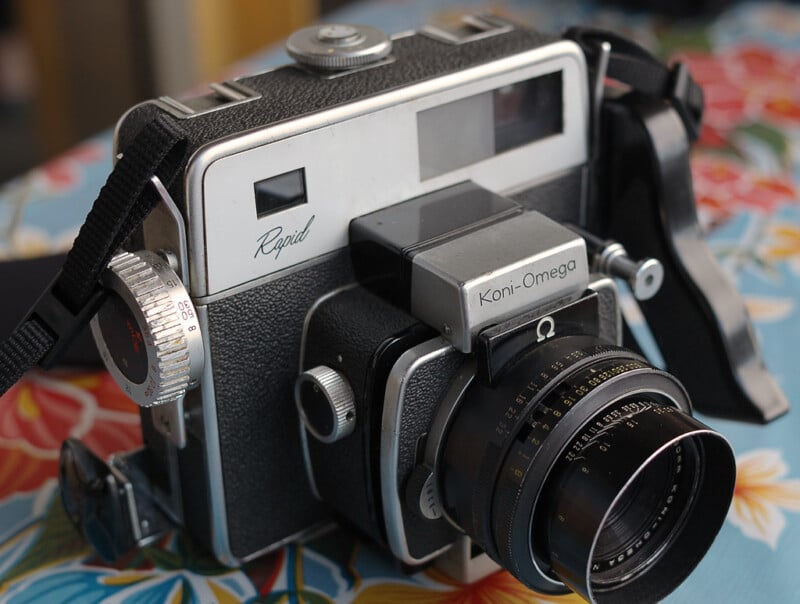
The Koni Omega Rapid 100 is a beast of a rangefinder that doesn’t mess around. This 6×7 workhorse is designed for photographers who need large negatives and fast operation. Its rapid film advance lever is satisfying to use and lives up to the “Rapid” name. The lenses, made by Konica, are incredibly sharp, with excellent color rendition and contrast.
The interchangeable backs and lenses make this camera versatile, whether you’re shooting portraits, landscapes, or documentary work. But let’s be real — this isn’t a camera you casually sling over your shoulder. It’s heavy, bulky, and demands commitment. That said, if you’re willing to deal with its size, the results are absolutely worth it.
Mamiya Six
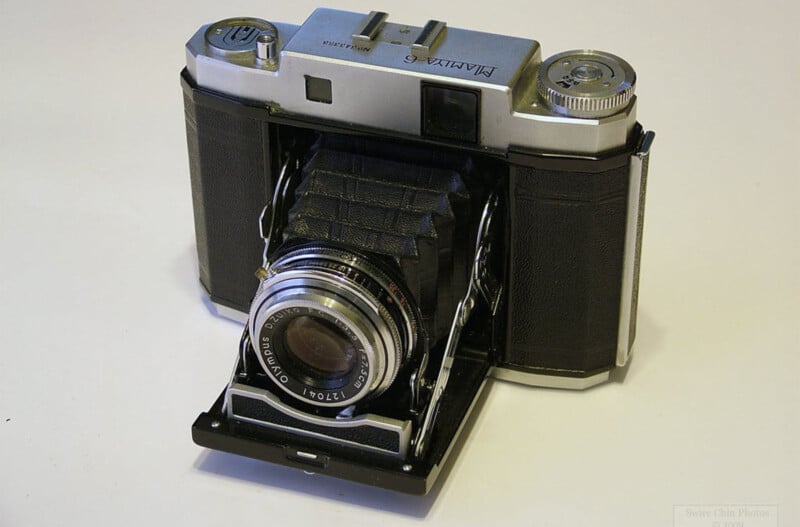
The Mamiya Six is the ultimate stealth medium format camera. Folding cameras often feel like relics, but this one stands out with its modern design touches. It shoots 6×6 negatives, has a coupled rangefinder for precise focusing, and packs it all into a body that folds down small enough to fit in a coat pocket. There are no bulky SLR vibes here — this is a medium format for photographers on the go.
Its Sekor lens is sharp and contrasty, capable of creating stunning detail, whether you’re capturing a bustling street scene or a quiet landscape. The automatic parallax correction is a nifty touch, especially when composing close-up shots. Of course, the folding design comes with its quirks — older models may have brittle bellows or focus stiffness. But for those willing to give it a little TLC, the Mamiya Six is an absolute gem for travel and everyday shooting.
(Not to be confused with the more modern, and significantly more expensive Mamiya 6)
Zeiss Ikonta
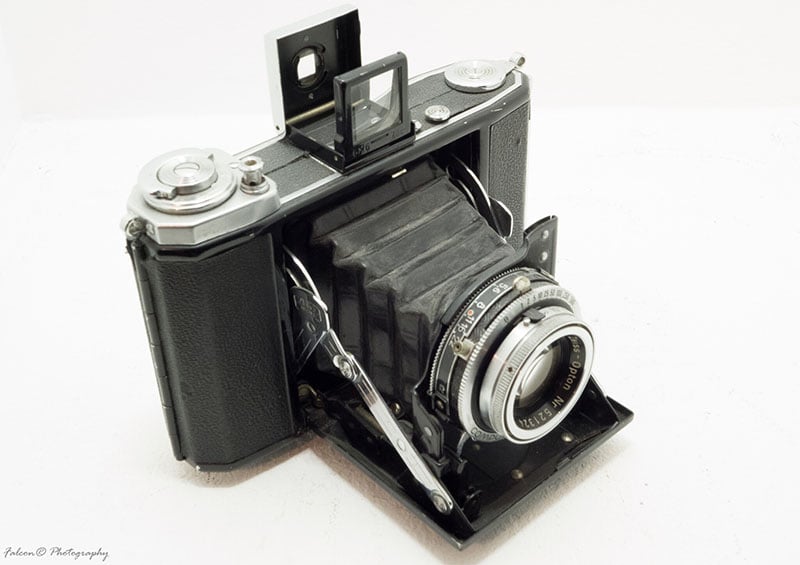
The Zeiss Ikonta is elegance in camera form. This folding medium format system feels more like a precision tool than a casual shooter. Available in formats ranging from 6×4.5 to 6×9, it’s versatile enough to suit your framing preferences. And the lenses? Classic Zeiss. Whether you’re working with a Tessar or Novar, you’ll get sharp, high-contrast negatives that sing with detail.
But don’t expect modern conveniences here — focusing is often guesswork unless you’ve got an external rangefinder. That said, the compact folding design makes this a fantastic travel companion. It’s great for photographers who want to slow down and savor the process of crafting an image, knowing they’ll be rewarded with stunning results.
Agfa Isolette III
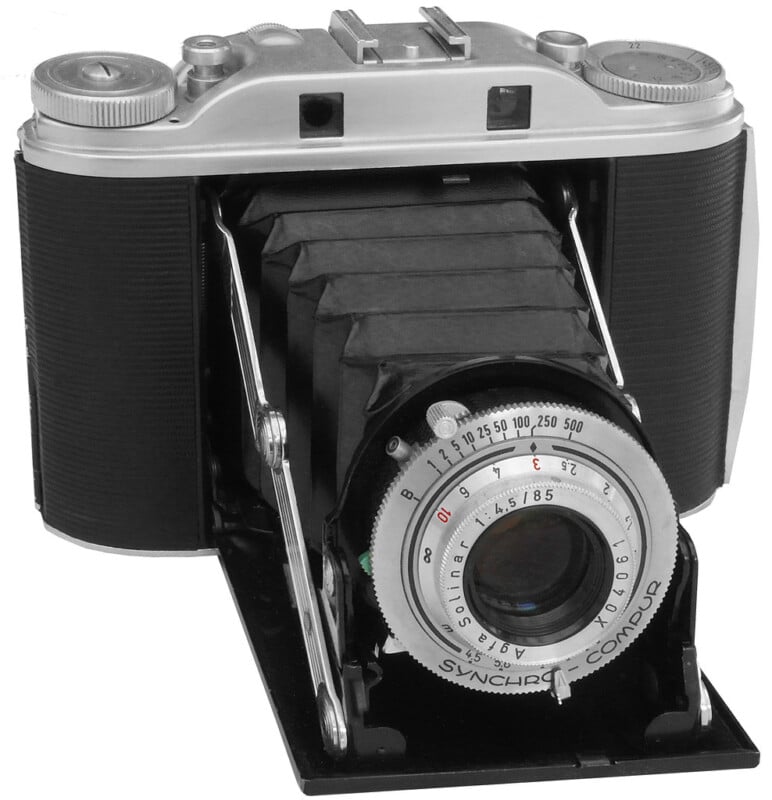
The Agfa Isolette III is the camera equivalent of a budget sports car — affordable, stylish, and surprisingly capable. This 6×6 folding camera pairs a compact design with high-quality lenses, like the Solinar or Apotar, that deliver impressively sharp results. It even features an uncoupled rangefinder, which feels like a luxury in a camera of this class.
Handling it feels like stepping back in time in the best way. The bellows fold neatly away, making it easy to carry on a hike or stow in a bag. However, vintage cameras like this often come with quirks. Many Isolette IIIs suffer from stiff focusing rings due to aging grease, but a bit of servicing will make it work like new. For anyone wanting to dip their toes into the medium format without breaking the bank, the Isolette III is a fantastic entry point.
Mamiya Press
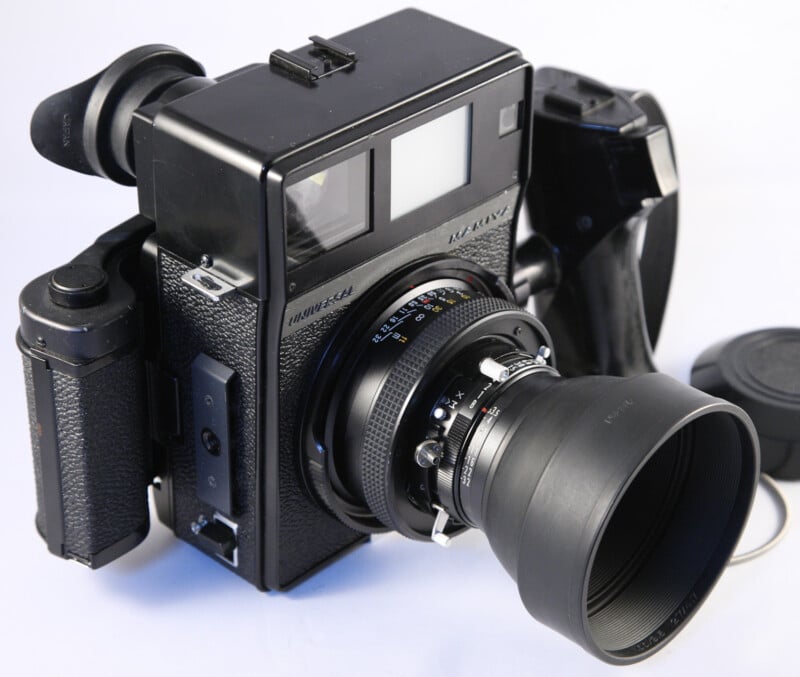
The Mamiya Press is less a camera and more a system built for creative control. This rangefinder is a true chameleon, offering interchangeable lenses, film backs, and even formats (6×7, 6×9, and beyond). Need to shoot in a studio? No problem. Want to switch from black-and-white to color mid-shoot? Just swap the back. The sharp Sekor lenses are the cherry on top, offering crisp results that rival the best in medium format.
But let’s talk about its size: it’s big. Really big. This is not the camera for a casual day out. It’s a serious tool for photographers who know what they’re doing and are willing to put up with a bit of bulk for the sake of versatility. If you’re up for the challenge, the Mamiya Press will reward you with some of the most detailed, beautiful negatives you’ve ever seen.
Fujifilm GS645
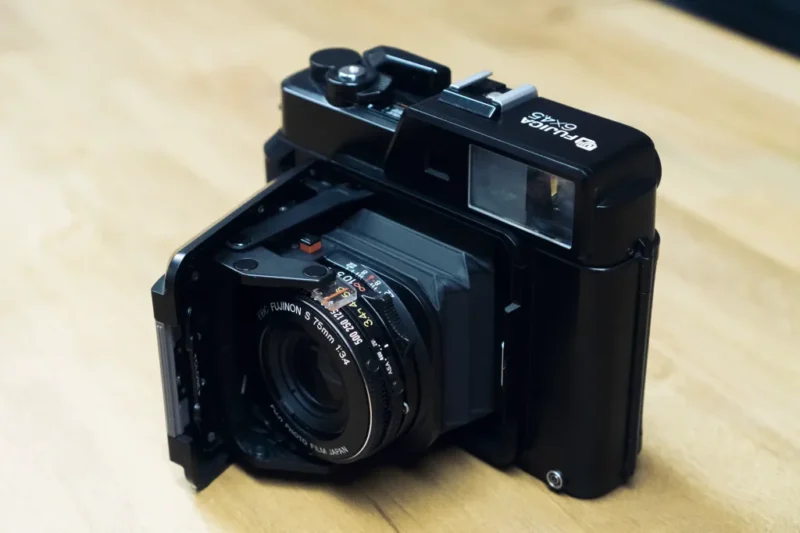
The Fujifilm GS645 might just be the perfect travel companion for medium-format photographers. It’s compact, light, and folds down neatly, yet still packs a punch with its EBC-coated Fujinon lenses. Those lenses are no joke — sharp, vibrant, and capable of rendering incredible detail. Shooting 6×4.5 negatives, the GS645 gives you plenty of frames per roll while maintaining that signature medium format look.
Its portability makes it ideal for landscapes, street photography, or anything that requires you to move fast. But the folding bellows design has a downside — if they get damaged, repairs can be tricky. Still, if you take care of it, the GS645 will quickly become your go-to for high-quality, travel-friendly shooting. It’s a camera that just makes sense when you want medium format without the bulk.
Medium Format Digital
Fujifilm GFX 50S
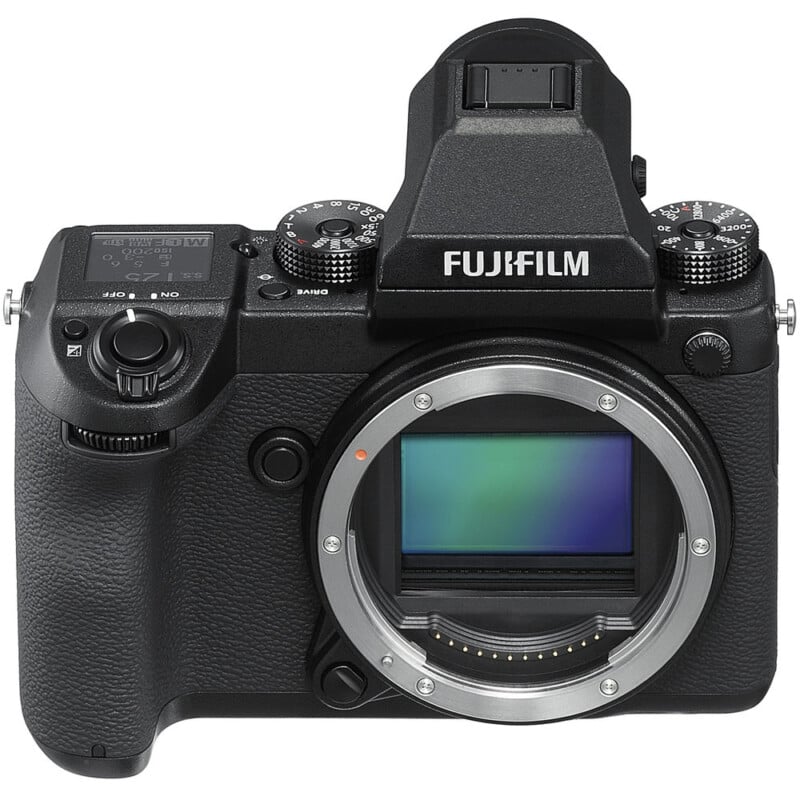
While the Fujifilm GFX 50S was barely beaten to the punch as the first medium format mirrorless camera by the next camera on this list, it’s undeniable the revolution it sparked in the world of larger format digital photography. With a 51.4MP 44x33mm CMOS sensor, this mirrorless camera produces files so detailed, you’ll feel like you can step right into them. Dynamic range is incredible, capturing highlights and shadows with ease, and the colors? Pure Fujifilm magic.
The GFX 50S is surprisingly ergonomic for a medium format camera, with weather sealing that makes it tough enough for the outdoors. The lens lineup is stellar, offering everything from ultra-sharp primes to versatile zooms. This isn’t a camera for casual snapshots, though. It’s designed for photographers who demand the highest quality, whether in the studio or on location. If you’ve ever dreamed of shooting medium format but didn’t want to deal with film, this is your golden ticket.
The biggest downsides to the camera are its size — Fuji has gradually shrunk the GFX line over time — and its rather lackluster autofocusing capabilities (and terrible video, if that matters at all to you). But for the price, the results are simply stunning.
Hasselblad X1D-50C
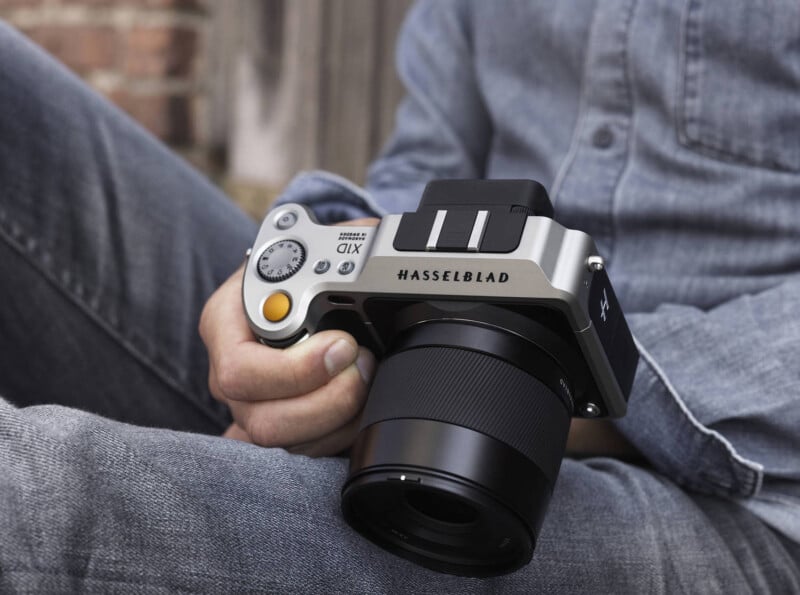
Sleek, stylish, and built for precision, the Hasselblad X1D-50C feels as much like a work of art as a tool. This mirrorless digital medium format camera offers the same 51.4MP sensor found in the GFX 50S but with Hasselblad’s famous Natural Color Solution. And that’s no gimmick; every camera is individually calibrated and loaded with data specific to that body, producing the best colors and tonality of any camera line out there, in this photographer’s opinion. The Scandinavian design is minimalist yet functional, with a compact body that’s remarkably portable for a medium format system.
The X1D isn’t just about looks, though. It pairs beautifully with Hasselblad’s legendary lenses, which deliver images that are sharp from edge to edge. The touchscreen interface is intuitive, and the camera’s build quality is second to none. While its autofocus isn’t the fastest, and the price of the lenses might make your wallet cry, the X1D-50C itself is a stunningly affordable entry to image quality that few cameras can match.
Pentax 645D / 645Z
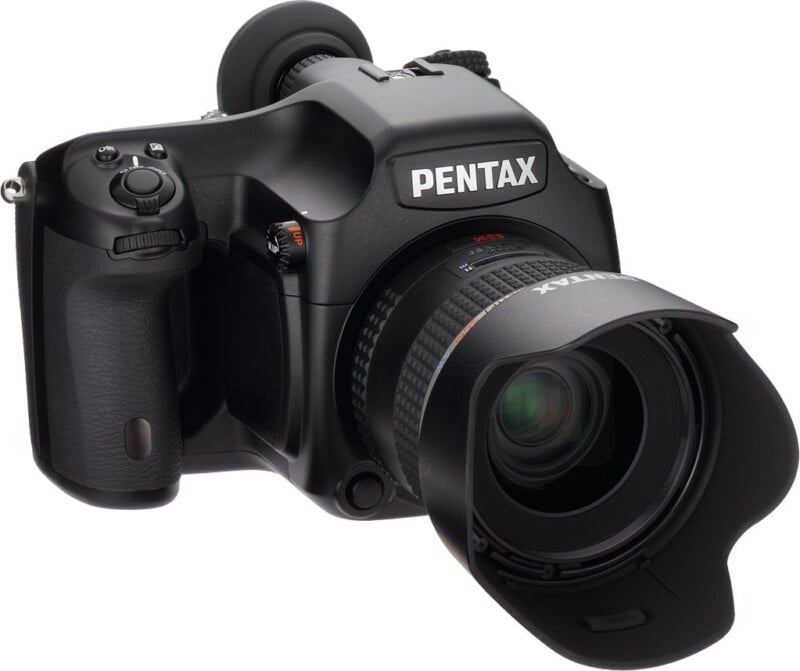
The Pentax 645D and 645Z were game-changers in the world of digital medium format. The 645D was Pentax’s first foray into digital medium format, packing a 40MP CCD sensor that delivered breathtaking detail and tonality. It’s rugged, weather-sealed, and surprisingly ergonomic for its size, making it perfect for landscape photographers who don’t want to baby their gear. The 645Z takes all that and kicks it up several notches. With a 51.4MP CMOS sensor — yes, the same one in the GFX and X1D — the 645Z offers better dynamic range, much higher ISO performance, and even live view, making it far more versatile than its predecessor.
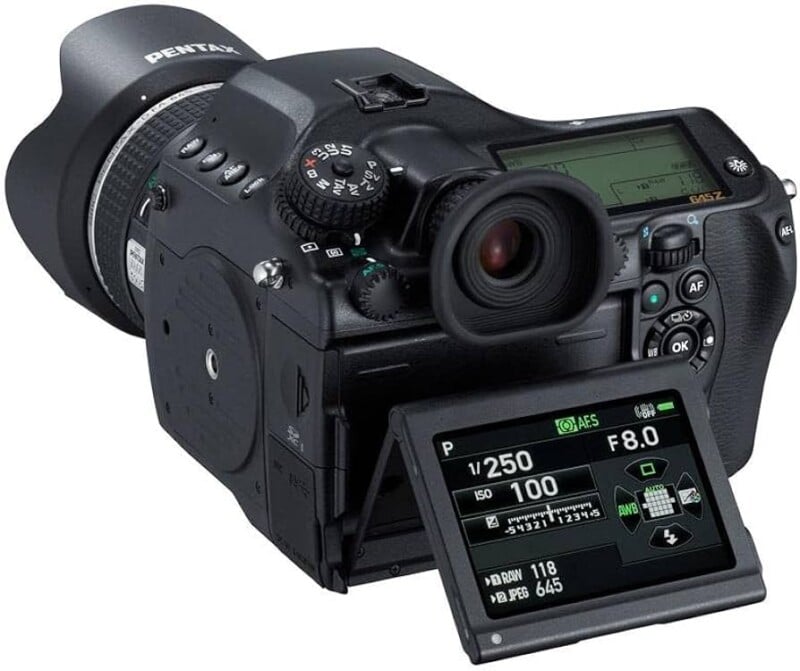
What sets these cameras apart is their user-friendly design. The DSLR-style handling means they feel natural, even for those new to medium format. And let’s not forget the incredible lineup of Pentax lenses, many of which are legendary in their own right — and many of them can be found quite affordably on the used market. The downside? They’re not as sleek, modern, or compact as mirrorless systems like the Fujifilm GFX or Hasselblad X1D, but they hold their own in terms of image quality. For those who need durability, dynamic range, resolution, and a cost-effective package in one solution, these are unbeatable options.
Mamiya ZD
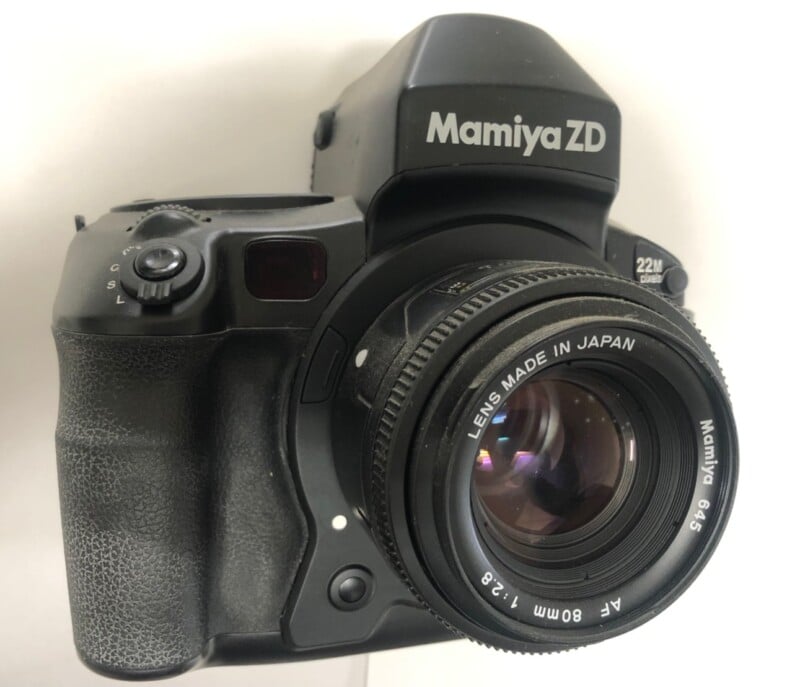
The Mamiya ZD is a bit of a cult classic in the medium format world. Introduced in the early days of digital medium format, it features a 22MP CCD sensor that may seem modest by today’s standards but still delivers beautiful, film-like images. It was groundbreaking when it launched, offering a fully integrated digital system at a time when most medium format cameras required third-party digital backs.
The ZD has a timeless feel, with Mamiya’s classic build quality and intuitive controls. Paired with Mamiya lenses, it produces sharp, detailed images with lovely color rendition. However, the camera is a product of its time — its comparatively slow performance and limited high-ISO capabilities to modern cameras make it less suitable for fast-paced or low-light work. Still, for those who want to explore the roots of digital medium format or need a reliable studio camera, the ZD is a charming option that still holds up.
Older Hasselblad, Phase One, and Leaf Aptus Backs
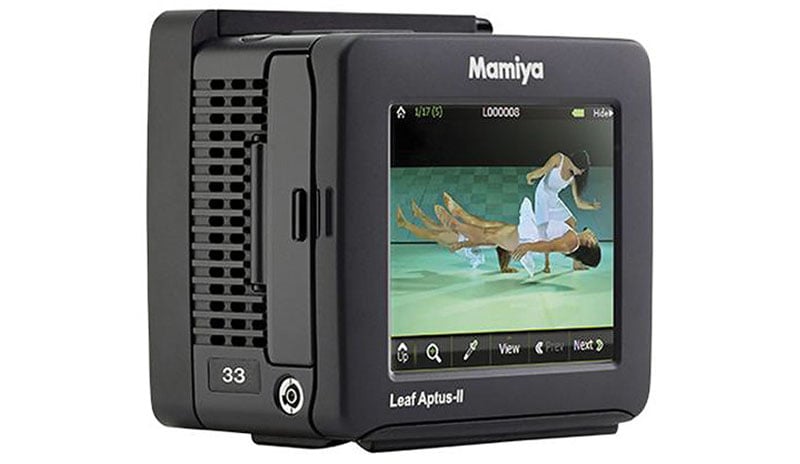
Digital backs from Hasselblad, Phase One, and Leaf Aptus represent the pinnacle of medium-format digital technology — at least for their time. These backs transformed existing film cameras into digital powerhouses, offering incredible resolution and dynamic range. Hasselblad backs are known for their intuitive interface and seamless integration with Hasselblad cameras, making them a favorite for studio shooters.
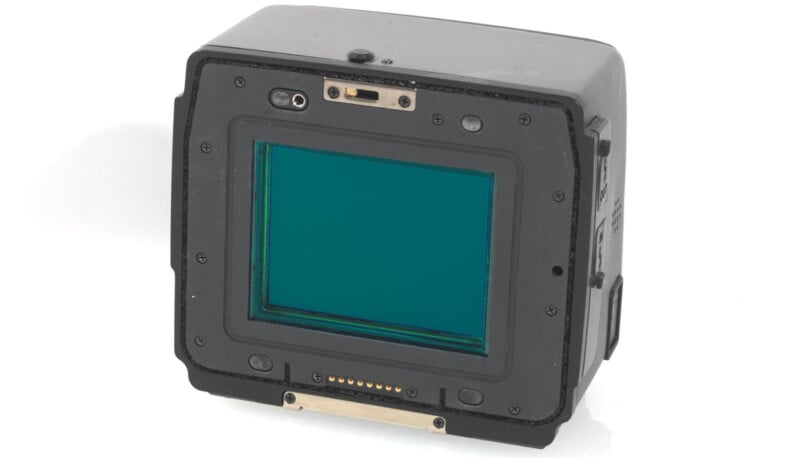
Phase One backs, like the P-series, are celebrated for their exceptional file quality and modularity, allowing them to work with various medium format systems. Leaf Aptus backs, on the other hand, focus on rich color profiles and easy tethering for studio workflows. The downside to all of these? They’re not exactly portable, and their older models can feel sluggish compared to modern mirrorless systems.
Despite this, these digital backs remain invaluable for photographers seeking ultimate sensor size and the ability to repurpose beloved medium format film systems. The large CCD sensors do create some truly singular images.
